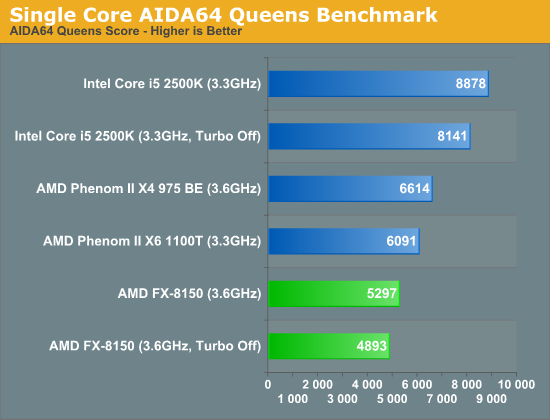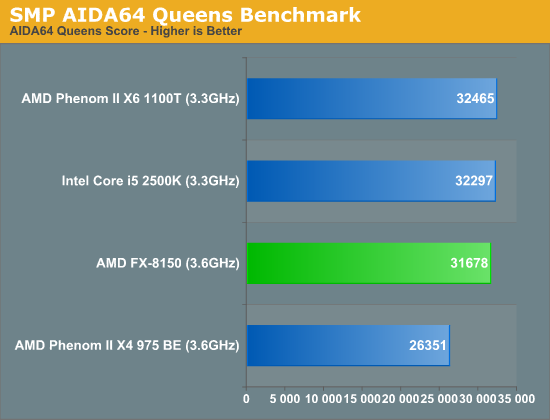The Bulldozer Review: AMD FX-8150 Tested
by Anand Lal Shimpi on October 12, 2011 1:27 AM ESTThe Impact of Bulldozer's Pipeline
With a new branch prediction architecture and an unknown, but presumably significantly deeper pipline, I was eager to find out just how much of a burden AMD's quest for frequency had placed on Bulldozer. To do so I turned to the trusty N-Queens solver, now baked into the AIDA64 benchmark suite.
The N-Queens problem is simple. On an N x N chessboard, how do you place N queens so they cannot attack one another? Solving the problem is incredibly branch intensive, and as a result it serves as a great measure of the impact of a deeper pipeline.
The AIDA64 implementation of the N-Queens algorithm is heavily threaded, but I wanted to first get a look at single-core performance so I disabled all but a single integer/fp core on Bulldozer, as well as the competing processors. I also looked at constant frequency as well as turbo enabled speeds:

Unfortunately things don't look good. Even with turbo enabled, the 3.6GHz Bulldozer part needs another 25% higher frequency to equal a 3.6GHz Phenom II X4. Even a 3.3GHz Phenom II X6 does better here. Without being fully aware of the optimizations at work in AIDA64 I wouldn't put too much focus on Sandy Bridge's performance here, but Intel is widely known for focusing on branch prediction performance.
If we let the N-Queens benchmark scale to all available threads, the performance issues are easily masked by throwing more threads at the problem:

However it is quite clear that for single or lightly threaded operations that are branch heavy, Bulldozer will be in for a fight.










430 Comments
View All Comments
B3an - Wednesday, October 12, 2011 - link
Yep this really is extremely disappointing. I'm actually going to call this AMD's Pentium 4. Thats how bad this is.2 billion transistors - thats a massive increase over the Phenom II X6 and what do we get? Nothing. The Phenom II is atleast as good with WAY less transistors and lower power consumption under load. I'm pretty shocked at how bad Bulldozer is. I wasn't expecting performance clock for clock to be as good as Nehalem, let alone Sandy Bridge, but this is just... appalling. When Ivy Bridge is out the performance difference is going to be MASSIVE.
Intel are surely going to implement more restrictions and hold there clocks speeds back even further. Theres just no competition anymore. Sad day for consumers.
bennyg - Wednesday, October 12, 2011 - link
AMD's Prescott to be exact... ironically that's one thing they seemed to shoot for in deepening pipeline and hoping that process would be better... hopefully this is just immature and soon there will be a GF110-style refresh that does it properly...Otherwise the whole next gen of AMD CPUs will continue to fight for scraps at the bottom of the heap... and their laptop CPUs will not even succeed there.
TekDemon - Wednesday, October 12, 2011 - link
I don't even know if it's just the process since those power consumption figures seem to suggest that they're being limited by the sheer amount of power it's using and the heat being generated from that. Intel had planned to take the P4 to 10Ghz but the fact that it was a power hog prevented that from realistically happening and it seems like you have the same issue here. The clockspeed potential is clearly there since it can hit 7Ghz under liquid nitrogen but for a normal air heatsink setup this is a recipe for failure. It's just way too power hungry and not fast enough to justify it. Why would anybody choose to use an extra 100 watts for largely the same or worse performance vs an i5 2500K?Thermalzeal - Wednesday, October 12, 2011 - link
I agree, 2 billion transistors are doing what exactly?The worst thing is that the water cooler isn't included with the FX-8150. At the performance levels they are providing, they should have just upped the price 30-50 bucks and provided the cooler gratis. Who's gonna need an AMD branded cooler if their not going to buy bulldozer?
The other point of these review is that there is no availability of any of the parts. So what a wonderful paper launch we have here. Seems like AMD isn't betting on anyone being interested enough to buy one of these things.
Blasphemy.
eanazag - Wednesday, October 12, 2011 - link
You can find them on Newegg today. The price is jacked up though. Newegg must not read AT.jleach1 - Friday, October 21, 2011 - link
Sigh...it's quite sad. There must be actual people buying these...either that or the supply is terrible. Because there's no way in hell i'd pay those prices for an AMD processor.defacer - Wednesday, October 12, 2011 - link
Like most people here, I 'm disappointed with BD performance -- even though I have never owned an AMD CPU after my 386DX/40 myself, competition in the performance segment would be nice for a change.I won't argue against "it's not 8 core", but calling it a 4-core is IMHO just as inappropriate (if not more).
yankeeDDL - Wednesday, October 12, 2011 - link
Ok, how about 4 modules, with 8 integer EU, 4 fetch, 4 decode, 4 L2 caches ...Point being, they are 4 modules, not 8 cores, and from many aspects, they are more similar to a 4-core CPU than to an 8-core CPU, being neither one (somewhere in between).
The fact of the matter remains: the IPC is bad. In multi-threaded, Integer-intensive tasks, BD should crunch the PhenomII X6 (2 more cores, higher clock speed), but it seems you can hardly see the difference. (ref: Excel 2007 SP! MonteCarlo sims).
AMD now is left with Llano as the only compelling reason to buy AMD over Intel (for netbooks and small notebooks, where Atom is the contender).
Against Core, either the FX-8150 goes down to $200 or less, or the i5-2500 is just a better buy for the money.
The advantage is I don't need a new MoBo (huge advantage for me, but not very compelling, in general).
yankeeDDL - Wednesday, October 12, 2011 - link
Forgot to mention, regarding the integer-intensive test: the core-i5 is slower by about 9% slower with 9% slower clock, but only 4 execution units (8 logical, with hyperthreading, but hyperthreading should be nearly irrelevant in this test).What a blow.
Ratman6161 - Wednesday, October 12, 2011 - link
We can argue about weather its really a 4 core or an 8 core, and the argument is interesting from a technical standpoint. But the proof is in the real world benchmarks. From a practical standpoint, if the benchmarks are not there (and they aren't) then the rest really doesn't matter.I looked on Microcenter where you can get a 2600K for $279 and a 2500K for $179. An i5-2400 is only $149. So AMD is going to be right back to having to cut prices and have its top end CPU go up against $149 - $179 Intel parts. Worse yet, it will, at least initially, be competing against its own previous generation parts.
There is one point of interest though and that is the fact that all the FX's are unlocked (according to the story). So it's pretty likely that an FX 8100 will probably overclock about as high as an 8150 once the process is mature. But there again, among overclockers, AMD could find its highest end 8150 competing against its own lower priced 8100.
Back in the day, I loved my Athlon 64's and 64 x2's and even though I have switched to an Intel Q6600 and then a 2600K, I still really want AMD to succeed...but its not looking good.